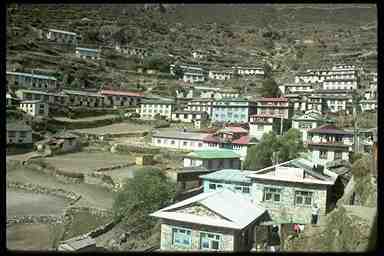
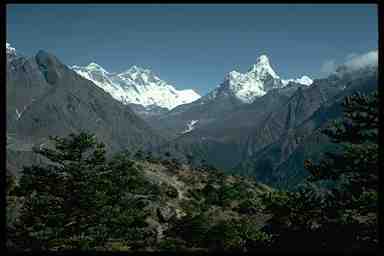



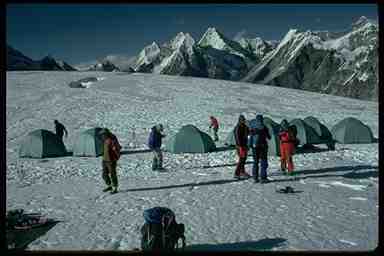
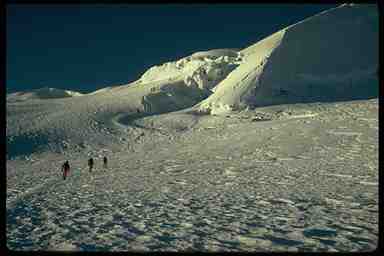

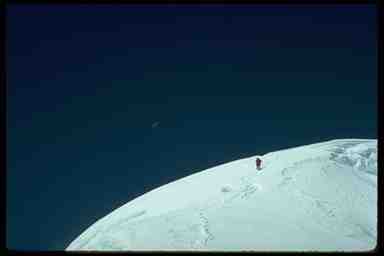
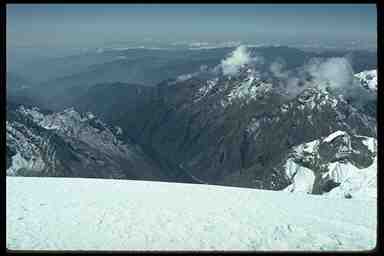
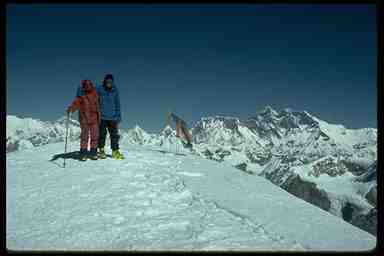
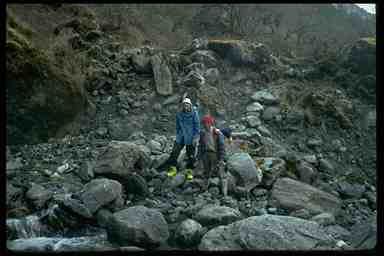
Back to Chronological List of Trips
Back to Home Page
My vacation this year was a one month trip to Nepal to trek through the Himalayas and to attempt to go to the top of Mount Mera. This reports the highlights of the trip.
I left October 20. My flights were Indianapolis, Chicago, Seattle, Bangkok Thailand and Katmandu Nepal. On the way I spent a night in the Bangkok Airport Hotel. I came back by the same route. The only problem coming back was a 14 hour delay in my flight out of Bangkok and the fact that my duffel bag didn't make it from Katmandu to Seattle. It arrived intact four days after I got home.
Within Nepal we took a helicopter from Katmandu to Lukla. From there we took a week to trek to Tengpoche, the same area I trekked through in 1985. This was mainly a warm- up and chance to acclimate to the altitude. We returned to Lukla from where we headed off on the second part of the trip to Mount Mera which took about two weeks. From Mount Mera we returned to Lukla where we helicoptered back to Katmandu.
I selected this trip for several reasons. First, I enjoyed my first trip to Nepal so much that I wanted to return. Second, I've had a goal of going over 20,000 feet altitude. This trip would allow me to achieve that goal. Third, I wanted a challenge which would be difficult but doable. This trip certainly supplied a challenge in attempting to reach the summit of Mera. Fourth, I wanted to be with the Sherpa people again. Sherpas are the people who live in the Mount Everest region of Nepal. They are wonderful people and do an excellent job of running these trips. Finally, I wanted to go on another trip with our trip leader. Sergio Fitch-Watkins was the leaded of my Mount Elbrus trip last year and was the leader of this trip.
The primary goal of the trip was to reach the summit of Mount Mera. To do this, we used a siege style climb. Siege style is opposed to Alpine style. Alpine style is fast and light but has lower chances of success. Siege style is slower and more expensive but also has higher chances of success.
We trekked to a base camp at 15,600 feet. Almost all of us felt the altitude when we arrived there. The next day was a rest day to give us a chance to acclimate. We used the time to take short day hikes to help us get used to the altitude. The next day we carried gear up to our high camp at 18,400 feet and then returned to base camp. This gave us 3 nights sleeping at base camp which greatly helped our acclimatization. The next day we moved up to our high camp to spend the night. This set a personal record for highest campsite I've slept at. I've had several previous camps at 17,000 feet. The next day we got up at 3am and started out for the summit at 4am. We were on snow the whole time but the trail was well marked and easy to follow. It took 6 hours to get to the summit at 21,200 feet. It was both exhilarating and exhausting. There were numerous time where I thought of turning back but never seriously considered it. From the summit it took two hours to return to high camp and then another two hours to return to base camp. Instead of 4 hours, it took me 5 hours to return to base camp, I was so exhausted by the ascent.
The actual summit was just a hill about 120 feet high. We dropped our packs at the base, grabbed our cameras and trudged up. When I got back down from this hill, I got tears in my eyes as I though of all of the time and effort that went into planning, training and preparation for this achievement. And, I wasn't thinking of just my own time and effort. A lot of people contributed in a lot of different ways to pulling this off. They were all there with me coming off the summit.
We got 13 of 15 people to the summit. This is an exceptional record for anything of this nature. There were three factors which lead to this success. First, we had a very strong group. Everyone was every experienced and well prepared for this trip. Second, we had excellent weather. We preyed for 3 days of perfect weather. We got 2.5 days of perfect weather which was enough. If there had been fresh snow or high winds, for example, our success rate might have been much lower. Finally, we had excellent support. Sergio, our Sherpas and the porters did an excellent job. While we did have to haul our own bodies to the summit, I never could have made it without the help we received from these people.
On the next to the last day of the hiking, as we returned to Lukla from Mera, we were coming down from a high pass. There was a lot of snow and ice and I wore my crampons for better footing. As we got lower, there was less and less snow and ice until the trail was mostly rock. I took off my crampons, not realizing how icy the trail still was. When I saw the trail condition I could have put them back on but chose not to. About 70% of the people in our group slipped and fell that day. Unfortunately I was the only one who didn't land on the trail. I slipped off the trail and tumbled about 3 or 4 times down the hillside. It happened so fast that I have no memory of any transition between being on the trail and tumbling. I only had time for the thought "Why me?" Once I stopped tumbling I had two thoughts: "Well, it didn't knock me out." and "At least I didn't break anything." While sitting there I noticed some blood. I had hit my chin on a rock on the way down and got a fairly deep cut. I held some snow to it to try to slow down the bleeding. About this time a sherpa noticed me and came down. He carried my pack for me and helped me down the trail to camp. I needed the help because I had strained some ligaments in the area of my right ankle and couldn't walk too well. Once I got to camp, Sergio and our trip doctor took a look at the cut on my chin and decided that I needed stitches. I got three stitches right there in camp.
The next day was the last day of hiking and was a short day. Someone carried my pack and I had Sergio and a sherpa to help me down the trail. Most folks took 1.5 hours to get back to Lukla. It only took me 2.5 hours. While I was slow, I could handle most things ok, maybe with some help, but ok. The only thing I worried about were the stream crossings I knew were coming up. These usually require a little speed and coordination, neither of which I had at the time. When we got to the first crossing, I stopped to try to figure things out. Sergio handed his pack to the Sherpa, walked up to me, turned his back and said "Hop on." He carried me across piggy-back. Once across, he set me down and said "You sure you don't want me to just carry you all the way to Lukla?" I declined the offer and made it to Lukla, mostly on my own power.
Namche is the largest village in the Khumbu (Everest) region of Nepal. Namche has a number of lodges where trekkers could stay. While camped in Namche on our way to Tengpoche someone suggested we go to a nearby lodge and get some tea and play some cards. On going into the lodge we saw a plaque above a door which said "President Jimmy Carter slept here 1985." He had trekked through the Khumbu in the fall of 1985 and must have stayed here. On going upstairs to the dining room we saw another banner "Dianne Feinstein for Governor." Also, Sergio had the equivalent of $30 in Nepalese money to pay to the head lama of the Tengpoche Buddhist monastery to perform a special service for Feinstein's campaign.
One reason I signed up for this trip was to be with Sergio again. I also saw the Sirdir from my previous trip to Nepal and had a chance to chat with him. (Sirdir is the Sherpa leader of a trip.) Finally, while in the Malla Hotel in Katmandu preparing to return home, I ran across the person I shared a tent with in Peru in 1981. We had quite a reunion. This was a record for running into people I knew from previous trips.
I've met my goal of getting above 20,000 feet. This also got me over 6,000 meters. I'm covered in both English or metric units. Having met my goal, I don't have any goals for higher altitudes. This doesn't mean that I might not attempt to go higher later but I have no such immediate plans.
For next year I'm thinking of taking a two week trip hiking through the Alps in Switzerland. I'm interested in a trip which is interesting but doesn't require extensive preparation like the last four I've done. Anyone interested in joining me?
In case you're wondering about the trip title, it comes from a saying of Sergio's. He's Mexican and sometimes when he would answer one of our questions he would add, "Of course, you know you should never trust a Mexican.
I did take it easy the next year doing a two week inn-to-inn hike through the Alps.











